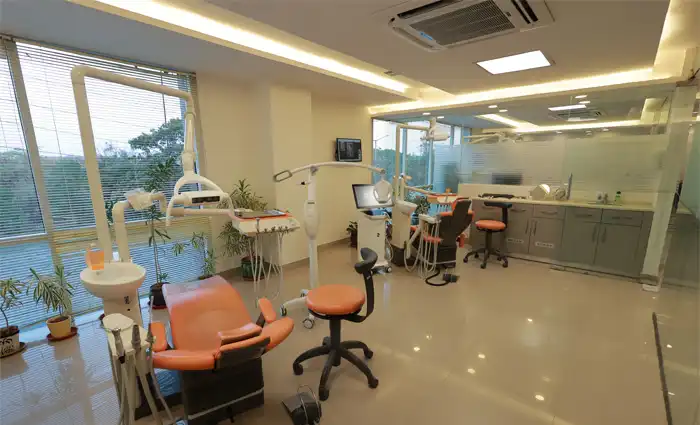Bite Raise
A bite raise is a procedure that is done on patients whose bite has collapsed over time. A collapsed bite occurs for various reasons, such as loss of enamel, loss of teeth. It restores the vertical dimension of occlusion, which is important for proper jaw functioning. Common conditions requiring a bite raise are:
- Bruxism (teeth grinding)
- Long term missing molars
- Severe wear of teeth with aging
Two Main Reasons for a Collapsed Bite
Following are the reasons that can lead to a collapsed bite.
- Tooth wear can occur due to a variety of reasons, such as age, bruxism (clenching your teeth), acid reflux, etc.
- The absence of molars for an extended period can lead to the collapse of teeth in that area, causing the jaw to overclose.
What Will Happen if You Have a Collapsed Bite?
This collapse in the bite will have a great impact on tooth function, and chewing efficiency is highly compromised. It will indirectly affect your TMJ (temporomandibular joint), giving you pain, clicking, or popping sounds. It will also result in a decreased height of the lower third of the face, which will have a direct impact on the facial appearance of the patient. Patients may also experience cracking of the corners of the mouth.
Types of Bite Raise Techniques
The bite lift method assists in clearing occlusion and stopping the upper teeth from colliding with the lower ones. It is used in vestibular, lingual, and even aligner-based orthodontic treatments.
Posterior Bite Lift
This lift is made on the occlusal side of the upper and lower molars and premolars. The objective is to de-occlude the prior region by opening the bite. It is recommended to make bilateral lifts in the second molars. Common ways to perform posterior lifts are by using mono-component photo-polymerizable resin with fluoride release.
Anterior Bite Lift
This lift is made on the palatal surfaces (maxillary teeth) of the upper central incisors, causing a posterior bite opening. This makes it possible for the molars and premolars to extrude, leveling the lower curve. As a result, in the case of a deep bite, the overbite can be improved. Orthodontists can use miniature molds to fill with composite, prefabricated bite lifts in composite, or make them directly on the tooth with composite restorations for this kind of lift.
Bite plates or splints
This method is used by orthodontists to correct the bites and manage the occlusal issues. The splint looks like a flat plan, and it is made of acrylic, which includes metal clasps that are attached to the teeth for stability.
Orthodontic adjustments
Braces are aligners that are most commonly used to correct bite issues. They are made up of metal wires, brackets, and bands that are attached to teeth by orthodontists. For bite issues, the braces are attached to bite blocks to prevent the upper and lower teeth from touching. Clear aligners are an alternative to traditional braces and are used to treat various bite issues, including open bites. These trays are personalized and can be easily taken out, fitting perfectly over the teeth.
What Can You Expect After a Bite Raise?
After the bite raise procedure, the patients can expect the following
- It will improve your chewing efficiency.
- It will prevent further tooth wear or damage.
- It will restore your facial profile, improving your aesthetics.
- It will decompress the TMJ and allow it to heal.
How is This Collapsed Bite Treated?
The main goal of bite raise is to restore the lost height of your teeth and give you a balanced bite. It is achieved by putting dental crowns over the worn-out teeth to restore the lost enamel and dentin and replacing missing teeth with dental implants and crowns.
Care and Maintenance Post-Bite Raise
It is important to take care of your oral health post-bite raise to ensure longevity and the overall success of dental treatment. Certain care and maintenance tips are:
Regular dental check-ups
Arrange regular appointments with your dentist for professional checking and maintenance of your dental reconstruction.
Oral Hygiene
Brush regularly with a soft-bristled toothbrush and floss to remove plaque between teeth and around the gum line to maintain oral health. Rinse your mouth with mouthwash frequently, especially after eating food.
Avoid hard or sticky foods
Hard and sticky foods may require much pressure to bite; a single bite can crack or dislocate a wire, chip, or even crack the tooth.
Wear a night guard
Wearing a night guard can protect your teeth, especially for those who have a habit of grinding or clenching their teeth.
Improve your bite and take care of your oral health with orthodontic treatment at Dr. Motiwala. We have a variety of options available, such as braces, clear aligners, and retainers, ensuring that there is a suitable solution for everyone.
Benefits of Bite Raise
Bite raise procedure offers various benefits, such as
- Improved bite alignment
- Correction of malocclusion
- Enhanced function of teeth and jaws
- Reduction of bite issue symptoms
- Relief from the pain and discomfort that comes with TMJ/TMD
- Fewer instances of teeth clenching and grinding
- Protection of teeth
- Prevention of further wear and damage
- Preservation of dental restorations




